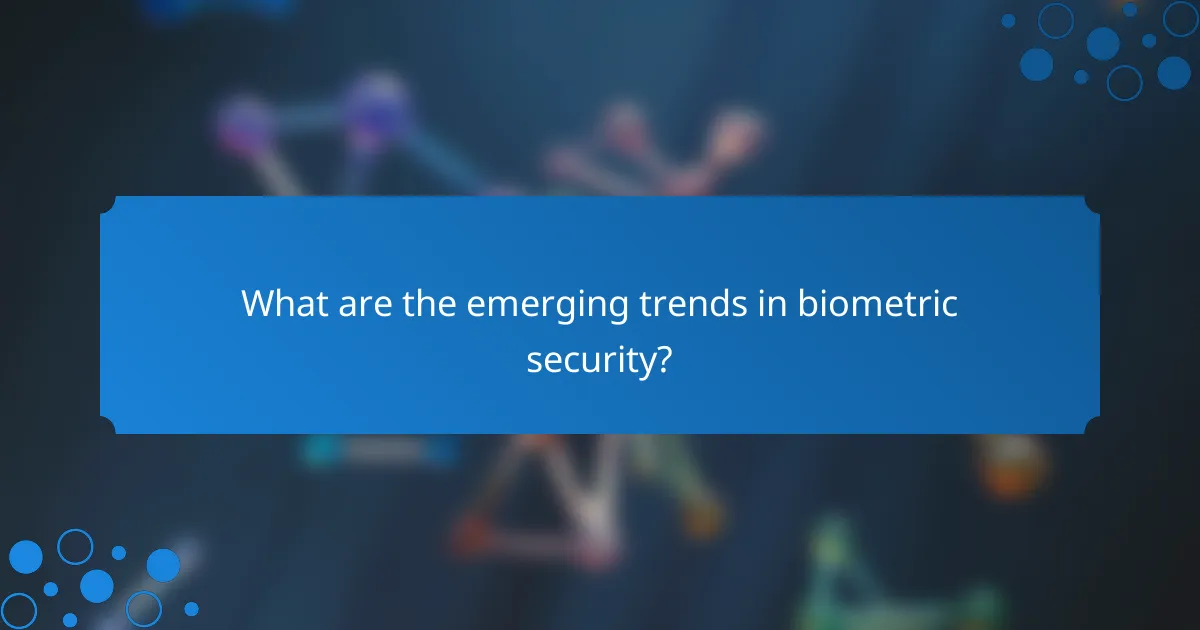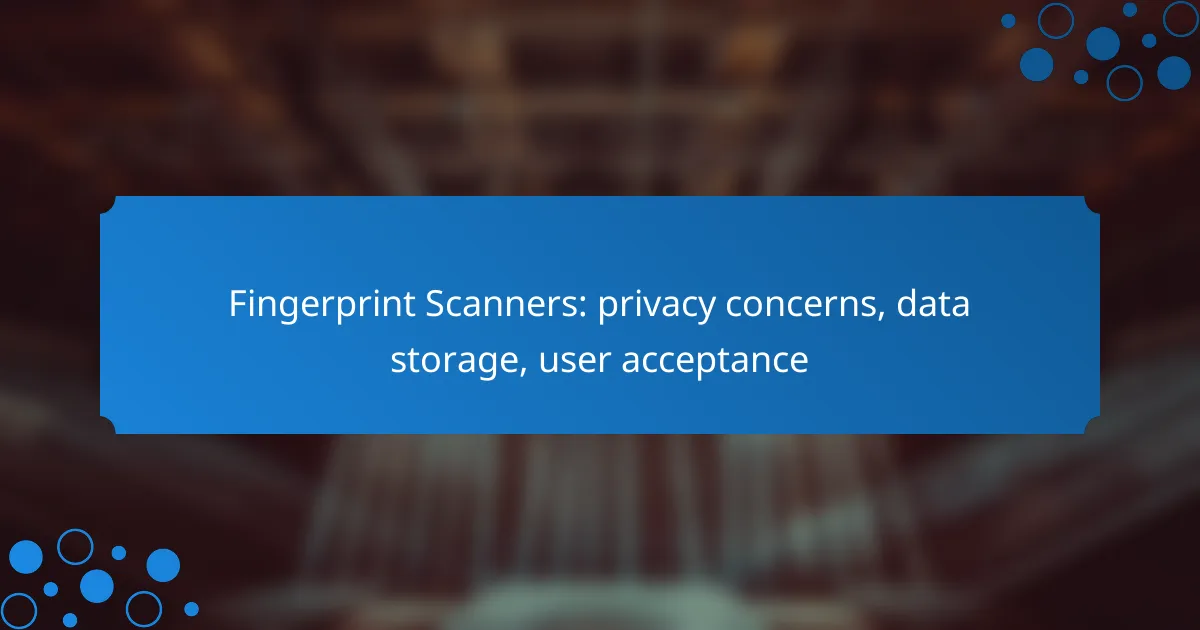Fingerprint scanners have become increasingly common in Canada, yet they raise significant privacy concerns regarding data misuse and unauthorized access. While the technology offers convenience and enhanced security, the storage and handling of biometric data necessitate careful consideration to protect user privacy. Understanding these dynamics is essential for fostering user acceptance and ensuring responsible implementation.

What are the privacy concerns of fingerprint scanners in Canada?
Fingerprint scanners in Canada raise significant privacy concerns primarily related to data misuse, unauthorized access, and surveillance implications. As biometric data becomes more prevalent, understanding these issues is crucial for users and regulators alike.
Data misuse risks
Data misuse risks involve the potential for biometric information to be exploited by unauthorized entities. If fingerprint data is not securely stored or transmitted, it can be intercepted or accessed by hackers, leading to identity theft or fraud.
Moreover, organizations may use fingerprint data beyond its intended purpose, such as for marketing or profiling without user consent. This raises ethical questions about how personal information is handled and shared.
Unauthorized access issues
Unauthorized access issues arise when individuals gain access to systems using stolen or improperly managed fingerprint data. Unlike passwords, fingerprints cannot be changed if compromised, making it crucial for organizations to implement robust security measures.
In Canada, regulations like the Personal Information Protection and Electronic Documents Act (PIPEDA) require organizations to protect biometric data adequately. Failure to comply can lead to legal repercussions and loss of consumer trust.
Surveillance implications
Surveillance implications of fingerprint scanners include the potential for increased monitoring of individuals by both government and private entities. The widespread use of biometric systems can lead to a surveillance society where personal movements and activities are constantly tracked.
In Canada, concerns about privacy and civil liberties have prompted calls for stricter regulations on the use of biometric data. Citizens are encouraged to be aware of how their fingerprint data is collected and used, advocating for transparency and accountability from organizations.

How is fingerprint data stored and secured?
Fingerprint data is typically stored in a digital format using various security measures to protect it from unauthorized access. This data is often converted into a mathematical representation rather than a direct image, which enhances security and privacy.
Encryption methods
Encryption is a critical component in securing fingerprint data. Common methods include Advanced Encryption Standard (AES) and RSA encryption, which transform the data into unreadable formats without the correct decryption key. This ensures that even if data is intercepted, it remains protected.
Additionally, some systems use end-to-end encryption, meaning data is encrypted on the user’s device before being transmitted to storage, further minimizing risks during transfer.
Data retention policies
Data retention policies dictate how long fingerprint data is stored and when it should be deleted. Organizations often implement policies that comply with privacy laws, retaining data only as long as necessary for their purpose, typically ranging from a few months to several years.
Users should be aware of these policies, as they can vary significantly between organizations. It’s advisable to inquire about how long your data will be kept and under what conditions it will be deleted.
Compliance with Canadian regulations
In Canada, organizations that handle fingerprint data must comply with the Personal Information Protection and Electronic Documents Act (PIPEDA). This law mandates that personal information, including biometric data, be collected, used, and disclosed only with consent and for legitimate purposes.
Organizations must also ensure that adequate security measures are in place to protect fingerprint data, including encryption and access controls, to meet regulatory requirements and safeguard user privacy.

What is user acceptance of fingerprint scanners in Canada?
User acceptance of fingerprint scanners in Canada is generally positive, with many individuals recognizing their convenience and security benefits. However, concerns about privacy and data security can influence overall acceptance levels.
Public perception surveys
Public perception surveys indicate that a significant portion of Canadians view fingerprint scanners favorably, particularly in contexts like mobile payments and security access. Surveys often reveal that while many appreciate the technology’s efficiency, a notable percentage express concerns regarding potential misuse of their biometric data.
Factors influencing acceptance
Several factors influence the acceptance of fingerprint scanners in Canada, including perceived security, ease of use, and privacy concerns. Users are more likely to accept these systems when they feel confident that their data will be protected and used responsibly.
Additionally, transparency from companies regarding data storage and usage can enhance trust. When users are informed about how their biometric information is secured and who has access to it, acceptance rates tend to increase.
Comparative acceptance with other biometric systems
Fingerprint scanners enjoy higher acceptance compared to other biometric systems, such as facial recognition or iris scanning, primarily due to their established presence in consumer technology. Many Canadians are already familiar with fingerprint authentication through smartphones, which fosters a sense of comfort and reliability.
In contrast, facial recognition technology often raises more privacy concerns, leading to lower acceptance rates. Overall, while fingerprint scanners are widely accepted, ongoing discussions about privacy and data protection will continue to shape user attitudes towards all biometric systems.

What are the best practices for implementing fingerprint scanners?
Implementing fingerprint scanners effectively requires careful planning and adherence to best practices that ensure security, user acceptance, and seamless integration. Key considerations include system integration, user training, and regular security audits.
Integration with existing systems
To successfully integrate fingerprint scanners, assess compatibility with current security systems and databases. Ensure that the scanners can communicate effectively with existing hardware and software to avoid operational disruptions.
Consider using open standards and APIs that facilitate integration. This approach can simplify the addition of fingerprint scanning capabilities without extensive modifications to existing systems.
User training and education
Providing comprehensive training for users is essential for successful adoption of fingerprint scanners. Educate users on how to properly use the devices, including techniques for capturing accurate fingerprints and troubleshooting common issues.
Regular workshops and informational materials can help users feel more comfortable with the technology. Highlight the benefits of fingerprint scanning, such as enhanced security and convenience, to encourage acceptance.
Regular security audits
Conducting regular security audits is crucial to maintain the integrity of fingerprint scanning systems. These audits should evaluate data storage practices, access controls, and compliance with relevant regulations to identify potential vulnerabilities.
Establish a routine schedule for audits, ideally every six months or annually, to ensure ongoing security. Implement findings from audits promptly to address any weaknesses and enhance overall system security.

What are the alternatives to fingerprint scanners?
Alternatives to fingerprint scanners include various biometric technologies that offer different methods of identity verification. Each alternative has its own advantages and drawbacks, impacting privacy, user acceptance, and data storage considerations.
Facial recognition technology
Facial recognition technology analyzes facial features to identify individuals. It typically uses cameras and algorithms to capture and compare images against stored data. While convenient, concerns about privacy and surveillance have led to regulatory scrutiny in many regions.
In practical terms, facial recognition systems can be effective in well-lit environments and may struggle with variations in lighting or angles. Users should be aware of the potential for false positives and the ethical implications of widespread surveillance.
Iris scanning systems
Iris scanning systems use high-resolution cameras to capture the unique patterns in a person’s iris for identification. This method is highly accurate and less prone to spoofing compared to other biometric systems. However, it often requires specialized hardware, which can increase implementation costs.
While iris scanning can be used in secure environments, such as airports or government facilities, user acceptance may vary. Individuals may feel uncomfortable with close-range scanning, raising concerns about privacy and data security.
Behavioral biometrics
Behavioral biometrics analyze patterns in user behavior, such as typing speed, mouse movements, and touchscreen interactions, to verify identity. This method does not require physical contact and can be integrated into existing systems for continuous authentication.
One advantage of behavioral biometrics is its ability to adapt to individual user habits, making it difficult for impostors to mimic. However, it may require extensive data collection and analysis, raising privacy concerns and necessitating clear data protection measures.

What are the emerging trends in biometric security?
Emerging trends in biometric security focus on enhancing accuracy, user acceptance, and privacy protection. Technologies like fingerprint scanners are evolving to address concerns about data storage and user trust while integrating with various applications across industries.
Privacy concerns
Privacy concerns regarding biometric security primarily revolve around data misuse and unauthorized access. Users often worry that their biometric data, such as fingerprints, could be stolen or misused, leading to identity theft or surveillance. Ensuring strong encryption and secure storage practices is essential to mitigate these risks.
Regulations like the General Data Protection Regulation (GDPR) in Europe emphasize the importance of consent and transparency in handling biometric data. Organizations must inform users about how their data will be used and stored, fostering trust and acceptance.
Data storage
Data storage for biometric information must prioritize security and compliance with relevant regulations. Biometric data is often stored in encrypted formats, either on-device or in secure cloud environments. On-device storage reduces the risk of data breaches but may limit functionality, while cloud storage offers scalability but raises concerns about data control.
Organizations should implement robust security measures, such as multi-factor authentication and regular audits, to protect stored biometric data. It’s crucial to balance accessibility with security to maintain user trust.
User acceptance
User acceptance of biometric security technologies, including fingerprint scanners, is influenced by perceived convenience and security. Many users appreciate the speed and ease of biometric authentication compared to traditional methods like passwords. However, concerns about privacy and data security can hinder acceptance.
To enhance user acceptance, organizations should educate users about the benefits and security measures in place. Providing clear information on how biometric data is collected, stored, and protected can help alleviate fears and encourage wider adoption.
